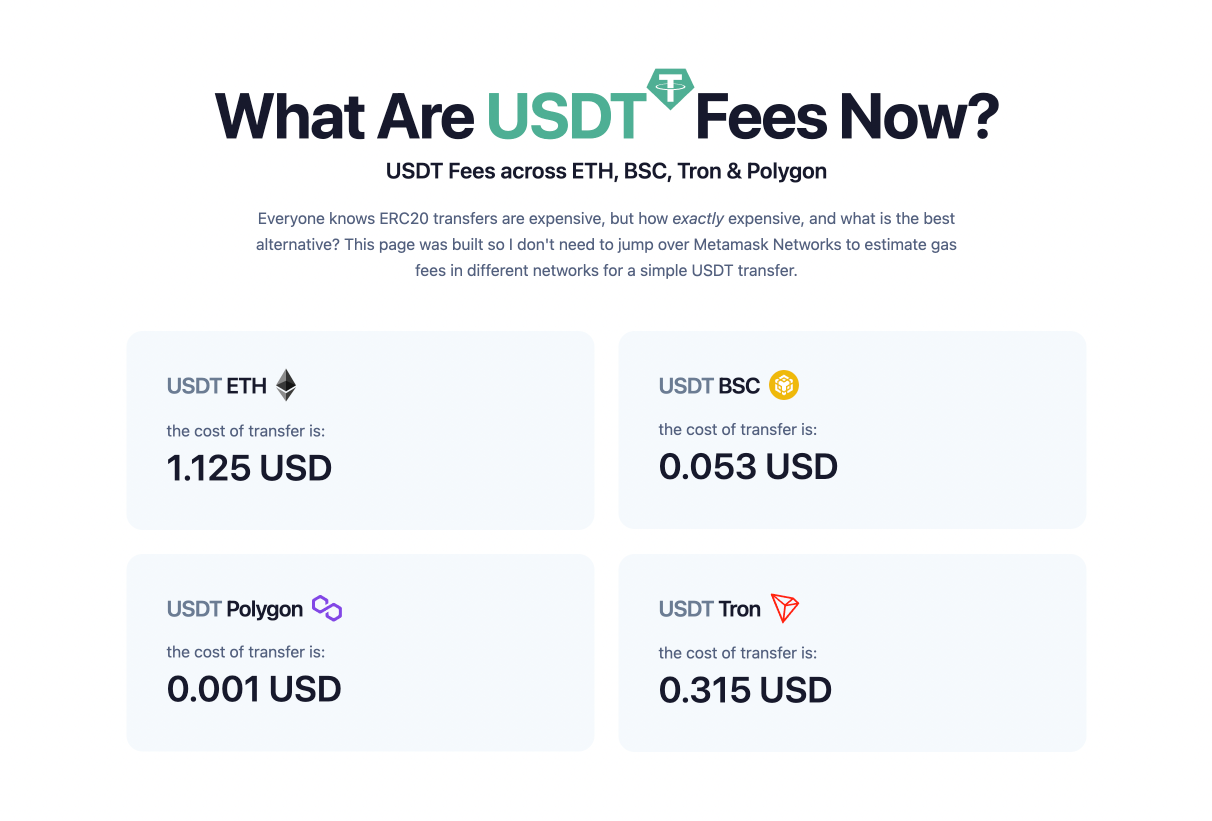What are USDT transfer fees now in BEP20, ERC20, TRC20?

Table of Contents
Have you ever wondered what is the best blockchain to send USDT and why Ethereum blockchain is so expensive (is it?) in terms of gas fees, and what is the best alternative?
I did. So, this is my new weekend project. It was built using 11ty for landing website, and Ethers for blockchain requests.
Disclaimer: I am not a world-class expert in blockchains, I am still learning it. But I am good at building products, and I have my 15 years of software development experience in a product-focused company, so I am taking my first humble efforts in improving the crypto ecosystem, particularly around payment transfers and processing (because this is where I felt the pain and this is where I can eat my own dogfood).
Here is the result: gasfeesnow.com

What is USDT?
USDT is the most popular stablecoin in crypto. Basically it is a cryptocurrency which is directly pegged to real US dollar so its value is almost always is equal to US dollar value. I have started accepting crypto payments recently for smaller projects, and while I was pretty skeptical regarding all these NFTs and other ICOs in crypto world, the simple, cheap, transparent and reliable alternative to bank money transfers was something I liked, because I saw a practical value in it. You can accept Bitcoin and Ethereum directly in your projects, but USDT are just a bit more convenient for money transfers because:
1) Everyone knows what USD is, so in USDT you instantly can evaluate the real amount of money you are operating with. This leads to a much friendlier user experience.
2) If you just got 100 USDT to your crypto wallet, they don't turn into 50 USDT overnight (well, there is no 100% guarantee, but at least it's much-much more stable than tokens not pegged to US dollar)
Which blockchains you can use to send USDT?
There are four major options when we talk about simple USDT transfers:
ETH (Ethereum native chain)
Main Ethereum chain with ERC20 tokens. The best in terms of ecosystem, obviously the most reputable, but the most expensive in terms of USDT transfer gas fees.
BSC (Binance Smart Chain, now called BNB)
Binance chain which became popular because it is convenient to load fiat money from Binance exchange. EVM compatible. The ERC20 contract in BNB ecosystem is called BEP20.
Polygon
EVM compatible level 2 network. Very cheap in terms of gas fees! And very fast. Why is it so cheap? I am not an expert in blockchains, so let me explain this like I understand it: the "level 2" means it is built on top of ETH blockchain, but it basically commits only "pointers" of the Polygon chain state to level 1 (ETH) blockchain.
Tron
Tron is the only one from these 4, which is not EVM-compatible. It started as almost 100% fork of Ethereum blockchain but deviated later.
Well, there are more networks supported by Tether, of course, but these are just my favorites!
Major conclusions and gotchas on USDT transfer fees
Avoid ERC20 and Ethereum mainnet
In short, the most expensive blockchain to transfer USDT now is ETH blockchain. This might change in future (when Ethereum mainnet switches to Proof of Stake consensus mechanism), but this is the current state (summer of 2022). So, you may want to use other 3 chains (or any other chains) for USDT transfers, especially when you transfer smaller amounts of money. Why? because there is no fun to pay 3 USD equivalent in gas fees, just to deliver 10 USDT to another wallet! And this is what happens in Ethereum blockchain. So if you have, let's say, 500 USDT in ERC20, and you plan to do 10-20 payments, the best thing you can do now is to transfer full amount of these 10-20 payments to a cheaper chain in a single transaction (and note that ETH blockchain fees are fluctuating from 0.7 to 3 USD during the day, so you might wait another 2-3 hours and save 1-3 USD on fees), and then do your smaller payments from cheaper blockchain.
All 4 blockchains have their own base (gas fee) currency.
You need to pay gas to transfer USDT. You might think that the commission might be taken from your USDT amount, but this is not the case! You need to have another currency (base blockchain currency) in the same wallet to be able to move your USDT.
So, for example, if you just got 100 USDT to your Polygon wallet (for example, you have moved your 100 USDT from Binance CEX) , you won't be able to transfer it to another Polygon wallet until you have enough MATIC currency in your wallet, because MATIC is the base currency of Polygon blockchain. Here is the list of base currency names (symbols) for mentioned blockchains:
Ethereum - ETH
BSC(BNB) - BNB
Polygon - MATIC
Tron - TRX
For Polygon and MATIC, you can easily get their base currency using so-called "faucet" websites, e.g. https://matic.supply/ - and it will be free for you. This is possible because you need just 0.001 USD worth of Matic to be able to move your USDT Polygon funds.
Why building another Gas tracker?
There are plenty of Gas Trackers out there, why building another one? Well, here are GasFeesNow.com advantages over existing gas trackers:
- Specializes on one single task - USDT gas fees. No complex graphs or hundreds of contracts. Minimalistic and clean design.
- Multiple chains on single page. ETH, BSC, Tron, Polygon on ONE page, without clicks!
- All fees are shown in USD. I still hate when gas trackers show GWEI prices, I just can't wrap my head around it.
- Blazing fast UI. GasFeesNow.com loads instantly. No ajax spinners. No slow rendering. 100% Chrome Lighthouse performance rating.
I found no trackers which can answer a very simple question "what is the cheapest network among major blockchains, for USDT transfer?" - I had to click and switch between multiple networks and websites, and MetaMask, to understand this. Now I just get to gasfeesnow.com and see the current situation with USDT gas at first glance.
Please try gasfeesnow.com and let me know if it was useful for you!